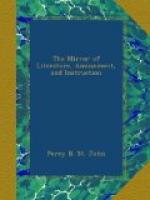THE MIRROR OF LITERATURE, AMUSEMENT, AND INSTRUCTION.
Vol. XIII, No. 357.] Saturday, February 21, 1829. [Price 2d.
* * * * *
[Illustration: Warwick castle.]
Warwick castle.
The history of a fabric, so intimately connected with some of the most important events recorded in the chronicles of our country, as that of Warwick Castle, cannot fail to be alike interesting to the antiquary, the historian, and the man of letters. This noble edifice is also rendered the more attractive, as being one of the very few that have escaped the ravages of war, or have defied the mouldering hand of time; it having been inhabited from its first foundation up to the present time, a period of nearly one thousand years. Before, however, noticing the castle, it will be necessary to make a few remarks on the antiquity of the town of which it is the chief ornament.
The town of Warwick is delightfully situated on the banks of the river Avon, nearly in the centre of the county to which it has given its name, and of which it is the principal town. Much diversity of opinion exists among antiquaries, as to whether it be of Roman or Saxon origin; but it is the opinion of Rous, as well as that of the learned Dugdale,[1] that its foundation is as remote as the earliest period of the Christian era. These authors attribute its erection to Gutheline, or Kimbeline, a British king, who called it after his own name, Caer-Guthleon, a compound of the British word Caer, (civitas,) and Gutieon, or Gutheline, which afterwards, for the sake of brevity, was usually denominated Caerleon. We are also informed that Guiderius, the son and successor of Kimbeline, greatly extended it, granting thereto numerous privileges and immunities; but being afterwards almost totally destroyed by the incursions of the Picts and Scots, it lay in a ruinous condition until it was rebuilt by the renowned Caractacus. This town afterwards greatly suffered from the ravages of the Danish invaders; but was again repaired by the lady Ethelfleda, the daughter of King Alfred, to whom it had been given, together with the kingdom of Mercia, of which it was the capital, by her father. Camden,[2] with whose opinion several other antiquaries also concur, supposes that Warwick was the ancient Praesidium of the Romans, and the post where the praefect of the Dalmatian horse was stationed by the governor of Britain, as mentioned in the Notitia.
[1] “Warwickshire,” p. 298, edit. 1661.
[2] Vide Camden’s “Britannia,”
by Bishop Gibson, vol. i. p. 603,
edit.
1722.




